
Custom Search
Decoupage - Coloring the Cut Edges of your Prints
DECOUPAGE TECHNIQUES - COLOURING THE CUT EDGES OF YOUR PRINTS
Colouring the cut edges
After you have all the prints glued down and you are happy with the design there is one very important step to follow before you seal your prints. Check once more to see if any white cut edges are showing. For this step you will need a few soft coloured pencils or Chinagraph Pencil in muted shades, to match your prints and blend in with the background. Colours darker than the prints are best.
Take your object into an area where there is good light such as near a window, in the garden or under a good bright light. Now search with your eyes carefully for every little bit of white where the paper was cut and colour it in with a pencil that will match the design. If your prints are very diverse in colours you may need quite a few different pencils. If your prints are mostly dark you may get away with just using a black Chinagraph pencil.
Take time with this step as it will really improve the look of your finished item.
When you are finished working on it by the window. Take a rest and then take it to a different light source and check and colour again. At different times of the day, and in different lights different things show up ... so take your time. When you are happy with this step you can start sealing the prints.
Decoupage - Gluing Down the Pictures
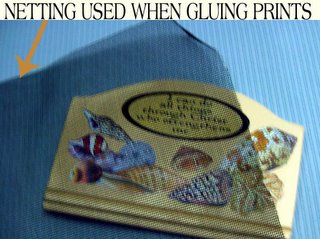
TECHNIQUES FOR GLUING DOWN THE PICTURES:
First make a Gluing Screen.
(See illustration above left.)
To make a gluing screen, you can use either a square of soft plastic window screen cut large enough to cover your entire project surface. You could also use nylon net, but with nylon net you will need to make it 2 or 4 layers thick, and stitch around the edges to hold the layers together. Using a screen over your print, and under your roller safeguards against the print getting damaged by the roller sticking to the print and pulling some of the printing ink off the paper and spoiling your picture. It also helps to get a very smooth bond by spreading the glue evenly under the print with little risk of damaging the print.
Sticking the prints down.
Using Decoupage Paste made according to the recipe below, Apply a generous amount to the back of your print. Take your time and allow the paper to soak up the glue. After the paper has soaked up enough glue to satisfy it's hunger, you must have enough excess to adhere to the item you are working on.
Place the glued print, glue side down on your project, and gently position it where you want it to be. Place the gluing screen over it and rub the print from centre to the edges (through the screen). When you are happy that there are no very large air bubbles remaining between the object and the print remove the gluing screen, take a damp sponge and gently remove any excess glue that has seeped out from under the print. Replace the screen and use a rubber roller and start rolling the print back and forth until it is absolutely and completely flat. Keep checking and rolling, check and roll. Do not rush this process as some paper tends to "pop up" if the glue has not taken hold properly. I usually roll my prints down for about a minute or more.
Prints may be layered one on top of the other to form your design. You can keep adding prints until you are happy with the results. This is where having lots of cut designs on hand is really good. That way you do not have to go back to cutting before completing your gluing session.
MAKING YOUR OWN DECOUPAGE PASTE
To make your own decoupage paste, used 3 parts of Clag Paste to 1 part of PVA glue which is the same as white glue, or Elners white glue.
MASTERING THE ART OF CUTTING
Beautifully cut prints will enhance the loveliness of your finished work. Poor cutting cannot be remedied so practice your cutting often. Try to cut every day. If you have nothing important to cut, try junk mail or magazine pictures. Start with simple designs and as you gain confidence tackle more difficult ones.
ORDER OF CUTTING
Cut out all the internal blank parts of the design first. This gives you more area to hold on to and allows more control. When cutting these inner bits cut in a clockwise direction. Start the cut by poking a hole through the middle of the area then insert the point of the scissors into the print from the back. The printed surface should be facing you, the scissors under the print.When all the inner bits have been removed, cut around the outer edges working in an anti-clockwise direction.
When cutting delicate bits that would tend to bend and maybe even break off, it is a good idea to cut “bridges” to help hold the cutting in shape until you are ready to paste it on your object. Draw them in with a dotted line before you begin the actual cutting. This helps you not to forget to cut in the bridge. You can use as many bridges as you feel comfortable with.
Cut away the bridges just before applying the paste or alternatively, and especially if the print is very fragile, apply the glue to the object, then place the dry cut print on the glued surface and gently wipe away the excess.glue with a damp sponge. It is a good idea to have about a dozen or so small pieces of sponge previously dampened and on hand when using this method. As you use each piece, put it into a container of water so the glue does not dry and spoil the sponge. At the end of the project wash the sponges out ready for the next project.
CHOOSING AND TAKING CARE OF YOUR SCISSORS
The more accurate you cut, the better your finished work will be. To achieve the best results you will need a small scissors with very sharp points and curved blades that feels comfortable to hold. A surgical scissors made for cutting the iris is ideal but a good cuticle scissors also works well provided both points are equally sharp. This type of scissors is available from surgical supply outlets, department stores, drug stores or craft supply shops that deal with decoupage. Never share your decoupage scissors with anyone as it moulds itself to your movements and when someone else uses it this gets thrown out of wack.
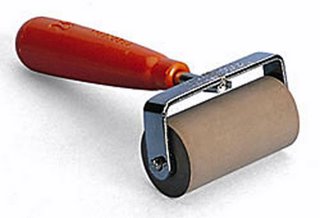
A brayer ... sometimes used to roll the prints flat after gluing.
USING SPONGES TO KEEP THE PROJECT CLEAN
Keep some damp sponges or damp rags handy for wiping off excess glue. Keep using fresh ones after you glue each piece down to avoid damaging your prints.
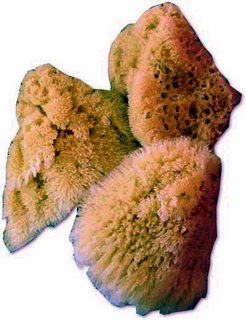 You do not need to use sea sponged. Kitchen sponges will do just fine.
You do not need to use sea sponged. Kitchen sponges will do just fine.
Decoupage - Mastering the art of cutting
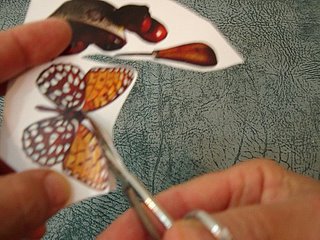
How to cut out prints for doing decoupage.
MASTERING THE ART OF CUTTING
Beautifully cut prints will enhance the loveliness of your finished work. Poor cutting cannot be remedied so practice your cutting often. Try to cut every day. If you have nothing important to cut, try junk mail or magazine pictures. Start with simple designs and as you gain confidence tackle more difficult ones.
ORDER OF CUTTING
Cut out all the internal blank parts of the design first. This gives you more area to hold on to and allows more control. When cutting these inner bits cut in a clockwise direction. Start the cut by poking a hole through the middle of the area then insert the point of the scissors into the print from the back. The printed surface should be facing you, the scissors under the print.
When all the inner bits have been removed, cut around the outer edges working in an anti-clockwise direction.
When cutting delicate bits that would tend to bend and maybe even break off, it is a good idea to cut ?bridges? to help hold the cutting in shape until you are ready to paste it on your object. Draw them in with a dotted line before you begin the actual cutting. This helps you not to forget to cut in the bridge. You can use as many bridges as you feel comfortable with.
Cut away the bridges just before applying the paste or alternatively, and especially if the print is very fragile, apply the glue to the object, then place the dry cut print on the glued surface and gently wipe away the excess.glue with a damp sponge. It is a good idea to have about a dozen or so small pieces of sponge previously dampened and on hand when using this method. As you use each piece, put it into a container of water so the glue does not dry and spoil the sponge. At the end of the project wash the sponges
Decoupage - Choosing the best type of scissors
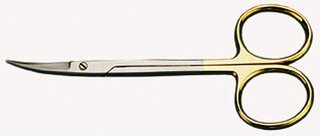
Decoupage Scissors
CHOOSING THE BEST TYPE OF SCISSORS
To get the best results and produce beautiful work you will need a small scissors with very sharp points and curved blades that feels comfortable to hold. The more accurate you cut, the better your finished work will be. A surgical scissors made for cutting the iris is ideal but a good cuticle scissors also works well provided both points are equally sharp. This type of scissors is available from surgical supply outlets, department stores, drug stores or craft supply shops that deal with decoupage. Never share your decoupage scissors with anyone as it moulds itself to your movements and when someone else uses it this gets thrown out of wack.
Tea bag tiles in block of sixteen tiles
Tea bag tiles in blocks of 16.
For small prints, copy directly from here. For full size prints click the thumbnail to enlarge.
Please read and follow my copyright rules.
Paper Dolls - Three paper dolls
For small prints, copy directly from here. For full size prints click the thumbnail to enlarge.
Please read and follow my copyright rules.
How to Make Flour Dough Beads - How did you do that?
 |
| Flower dough beads |
 |
| Flour dough beads |
 |
| A mixture of handmade beads and bought beads. |
Ingredients
4 cups flour
1 cup salt
1 1/2 cups cold water
Food coloring (optional)
INSTRUCTIONS
- Thoroughly mix the flour and salt together.
- Add water and mix well.
- Knead the mixture just like you would if you were making bread for ten to fifteen minutes. or until it feels flexible like dough.
- Using small pieces of the mixture, shape each piece into a bead. You can made different shapes like balls, egg shapes, square, hearts etc.
- Beads usually need holes to string them on ... make the holes with a wooden skewer or any other long pointy object that you have on hand.
- Place the beads on a baking tray and bake in an oven at 250ºF or 120ºC for two or three hours or untill they are completely dry and hard to the touch.
- Remove the beads from the oven and let them cool naturally. A fan might help if you are in a hurry.
- Decorate the beads with paint in plain colors or you coud add dots or stripes to make them look pretty. Dry them on a skewer or long piece of coathanger wire to protect your paint job.
- When the paint is completely dry you can coat them with varnish or ... I like to use Royal Coat by plaid.
15 Different Tea Bag Folds all on one post
A collection of crafty clipart decoupage, card and scrapbook prints all with a leopard spot pattern. Mix and match the prints together. This collection includes, tea bag tiles, borders, blanks in shapes to make pretty signs, flowers, labels, fruit and vegetables, hearts, dolls, toys, fashions prints, crockery, backgrounds, ribbons and bows, potted plants, miscellaneous prints.
For small prints, copy directly from here. For full size prints click the thumbnail to enlarge.
Please read and follow my copyright rules.
Make your own Papier Mache Paste - How Did You Do That?
How to Make your own Paper Macher Paste - How did you do that?
Make your own Paper Mache Paste
1 cup cold water
1/4 cup flour
5 cups boiling water
(2 tablespoons white glue)
Mix the flour into 1 cup cold water. Stir until all the lumps are dissolved. Gradually pour the mixture into boiling water, stirring constantly. Boil for about 3 minutes, stirring constantly. Cool, then add 2 tablespoons of white glue before you use it. the white glue helps to make it stronger and also helps to preserve it
Keep any un-used paste in the fridge in a covered container.
One nice little trick when doing paper mache is to use two different types of paper. One could be newspaper, and the other could be old magazine paper or used gift wrap. This allows you to see clearly when you have completed an entire layer without missing gaps or overlapping some areas.
Make your own Paper Mache Paste
1 cup cold water
1/4 cup flour
5 cups boiling water
(2 tablespoons white glue)
Mix the flour into 1 cup cold water. Stir until all the lumps are dissolved. Gradually pour the mixture into boiling water, stirring constantly. Boil for about 3 minutes, stirring constantly. Cool, then add 2 tablespoons of white glue before you use it. the white glue helps to make it stronger and also helps to preserve it
Keep any un-used paste in the fridge in a covered container.
One nice little trick when doing paper mache is to use two different types of paper. One could be newspaper, and the other could be old magazine paper or used gift wrap. This allows you to see clearly when you have completed an entire layer without missing gaps or overlapping some areas.
How to Make a Little Book / Book Thong - How did you do that?
The little book thong above with the little book attached is so easy to make
YOU WILL NEED
A couple of sheets of A4 typing paper
Some pretty lightweight card for the cover. (a scrap of scrapbook page woud be great)
A piece of very narrow pretty ribbon or yarn.
A very large needle capible of threading with the ribbon or yarn.
Some beads..
HOW DID YOU DO THAT?
- Cut the sheet of A4 paper into 5 equal parts cutting along the narrow part of the pages. ... you should have 10 little sheets of paper.
- Cut the pretty lightweight the same size to use for the cover
- Fold one of the little sheets of paper in half to mark the center line.
- Use a hammer and nail, or a very large needle and punch three holes along the center line as shown in the diagram below. Punch right through all the sheets and the cover all at the same time so that the holes are all in exactly the same place.
- Thread the yarn or ribbon on the large needle and following the diagram below, thread the pages together.
- Pull the yarn fairly tightly and tie a knot as shown in the picture above.
- Leave enough length on the ribbon or yarn to fit through the pages of your book plus an extra inch or so and tie a nice thick knot ... one knot over another to keep your beads from moving.
- Thread the beads on, then secure with a last knot close up to the last bead
- You are threading. Down in to A, Up through B, Down into C, then up into A.
- Adjust the lengths of the yarn so one short length is left to tie the knot about 10 cm in length or approx four inches long. Leave the rest of the yarn attached to the ball or spool for noww.
- Measure enough lenght on the yarn to fit in the pages of your book, plus one inch, plus enough extra for the beads etc. (Approx. another 12 inches or so) .
 |
| After threading the pages together, pull tight and tie a knot. Then trim the end of the short piece of ribbon. |
How to Make a Welcome Sign - How did you do that?
How to make your own welcome sign or key keeper.
Follow the pictures in the slide to see how it is done, ... You will need a print so if you do not already have one, click on the sample sign thumbnail to get it full size and save it to your computer. Print it out as large as possible on your printer using the "scale to fit" settings and the "keep aspect" settings.
When the printing ink is dry, seal it with a spray on sealer. Allow the sealer to dry according to the manufacturers instructions then cut out the print as accurately as you can with a sharp decoupage or cuticle scissors.
Step 01: (see slide)
Mark a pattern on a piece of scrap paper by measuring all around the print that you cut out about 1 1/2 cm or approximately 5/8 inch, all the way around the print.
Step 02: (see slide)
Transfer the pattern on to a piece of scrap timber or MDF (craftwood).
Step 03: (see slide)
Cut out the board with a jig saw following the lines of the traced pattern trying to cut as accurately as you possibly can.
Step 04: (see slide)
Sand the edges of the board starting the coarse sandpaper, then whigh medium sandpaper, then finish off with fine sandpaper. Wipe off any dust residue with a damp (not wet) rag.
Step 05: (see slide)
Paint the board with your background colour following the manufacturers instructions
Step 06: (see slide)
Decoupage the print that you cut out earlier on to the board. You can find instructions on how to do this here.
How to make those pretty bead sticks - How did you do that?
Pretty Bead Sticks. - How did you do that?
HOW TO INSTRUCTIONS
You will need ...
Straws
8 ply colored yarn of any kind.
Scissors
Elmers White Glue
Water
Piece of old towel
Skewers for putting the straws to dry
INSTRUCTIONS:
1. Cut a slot about 1 cm into each end ofa straw.
2. Pass the end of the yarn through the slot and lay the end of the yarn against the straw and hold on to it.
3. Start wrapping the yarn around the straw and also around the loose end that you are holding down, keep pushing the wrapped yarns close up tight against each other as you go.
4. When you have the whole straw wrapped right down to the other end where you cut the second slot, pass the yarn through the slot and secure it by tying a know.
5. When you have a few straws wrapped it is time to glue the yarn together so they don't come unravelled when you cut them.
6. Dilute some of your elmers glue half/half with water. and paint your wrapped straws making sure the glue is well soaked in. Then roll the glued yarn rolled straw on a soft piece of old towelling to get rid of any excess glue and bring the surface of the yarn back to it's natural look. If you skip this step, you may end up with some ugly looking bead sticks with shiny spots or dull opaque spots. It helps if you put a skewer through the straw so you can stand it up to dry.
7. If you are going to be doing lots of these, you can drill holes in a piece of heavy timber so you have something to stand the skewers up onto. If you are only going to be making one batch, then stand them up at an angle against the edge of a wall or cardboard box.
Once these bead sticks are dried hard, they can be cut to any size with a safety blade.
HOW TO INSTRUCTIONS
You will need ...
Straws
8 ply colored yarn of any kind.
Scissors
Elmers White Glue
Water
Piece of old towel
Skewers for putting the straws to dry
INSTRUCTIONS:
1. Cut a slot about 1 cm into each end ofa straw.
2. Pass the end of the yarn through the slot and lay the end of the yarn against the straw and hold on to it.
3. Start wrapping the yarn around the straw and also around the loose end that you are holding down, keep pushing the wrapped yarns close up tight against each other as you go.
 |
5. When you have a few straws wrapped it is time to glue the yarn together so they don't come unravelled when you cut them.
6. Dilute some of your elmers glue half/half with water. and paint your wrapped straws making sure the glue is well soaked in. Then roll the glued yarn rolled straw on a soft piece of old towelling to get rid of any excess glue and bring the surface of the yarn back to it's natural look. If you skip this step, you may end up with some ugly looking bead sticks with shiny spots or dull opaque spots. It helps if you put a skewer through the straw so you can stand it up to dry.
7. If you are going to be doing lots of these, you can drill holes in a piece of heavy timber so you have something to stand the skewers up onto. If you are only going to be making one batch, then stand them up at an angle against the edge of a wall or cardboard box.
Subscribe to:
Posts (Atom)









































